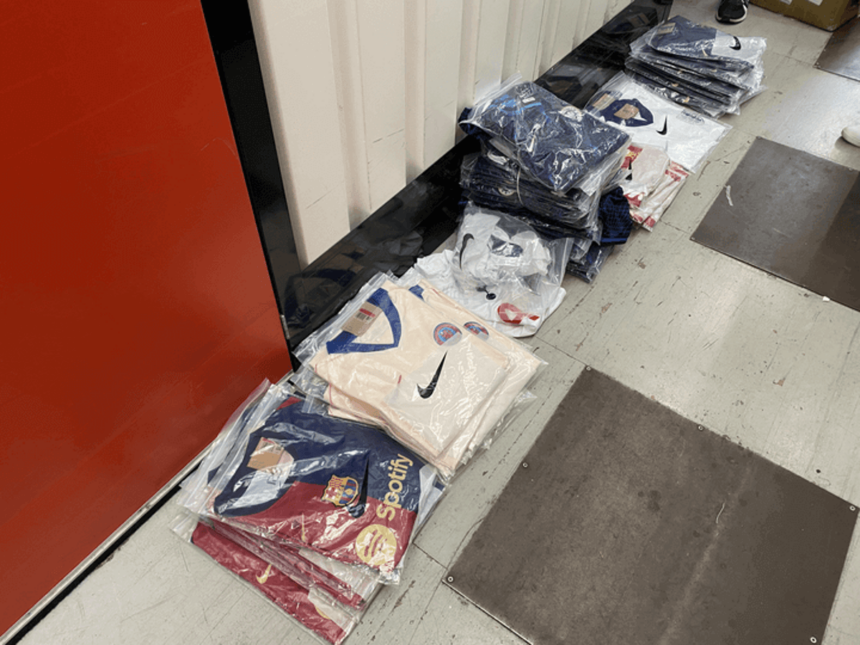Following the release of our nine-month investigation into the underground world of fake football shirts, The Athletic followed up by surveying subscribers on the issue. The results reinforced the idea that there is a growing market for counterfeits due to the rising costs of buying the genuine article.
There were hundreds of respondents — representing clubs from around the world, but predominantly those in the Premier League — and just shy of 78 per cent said they had knowingly purchased a fake shirt.
This is a significant increase on the 52 per cent of supporters from England’s top division surveyed during the course of the original investigation.
The market for fakes — which breach clubs’ and brands’ intellectual property rights — is now worth £180million ($233m) with 16.2 million shirts being sold per year, according to analysts Corsearch.
It shows no signs of stalling either, with nearly 66 per cent of respondents to the survey saying they would purchase a fake either again in the future or for the first time. There’s room for further growth too, with 13 per cent highlighting that they were still unsure.
So why are fans turning to fakes? It’s overwhelmingly because of the high prices of the real thing, according to our survey. Standard Premier League adult shirts can cost £85 before any customisation, whereas counterfeit versions are as low as £8.
Subscribers from 15 countries — including supporters from the big five European leagues, the rest of the UK and the United States, plus the Netherlands, Switzerland, Portugal, Serbia, Brazil and Argentina — voted for cost as their main motivating factor at nearly 84 per cent.
“It’s getting increasingly hard to justify the cost of the shirts on behalf of the industry that I’ve spent my career in,” former Puma and Umbro designer Rob Warner told The Athletic during the investigation. “There’s a perfect storm in the football world at the moment, where everybody wants the latest shirts, there are too many of them, they’re too expensive and the quality of counterfeits has improved.”
The Athletic highlighted various risks attached to supporting the illicit trade — including links to organised crime, terrorism and unfair working practices — but it appears these don’t act as a significant deterrent.
When asked what worries fans most about buying a fake shirt, 42 per cent of respondents said ‘Nothing’. Human trafficking and labour abuses were on the radars of 26 per cent of those surveyed, while 15 per cent were concerned about data theft and almost nine per cent by links to organised crime.
Advertisement
Dr. Ulrika Bonnier, from the Transnational Alliance to Combat Illegal Trade (TRACIT) told The Athletic that, “given the illegal nature of counterfeiting, everything that happens is outside of the normal controls and oversight that a labour force would normally have which makes those workers very vulnerable to abuse”.
During the course of the investigation, The Athletic approached all 20 Premier League clubs to ask if they would support a price cap on official shirts. The aim of this would be to reduce the gap between the prices of the fakes and the genuine shirts to try to cut down the temptation to turn to the counterfeit market.
Only two clubs — Ipswich Town, who have one of the cheapest kits in the division, and Brentford, who stagger kit releases across multiple seasons – even engaged in questioning. Both clubs felt they were taking active steps to reduce the financial burden on supporters. Wolverhampton Wanderers’ kit supplier SUDU, which also makes one of the cheapest kits in the league at £58 said it aimed to fix “a broken model” by cutting out “middlemen”.
Four clubs — Liverpool, Tottenham Hotspur, Leicester City and West Ham United — offered no comment when asked about the cap, and the other 14 — including Manchester United, Manchester City, Chelsea, Arsenal and Newcastle United — didn’t reply.
While many teams prefer to stay silent on the issue, the message from fans surveyed is loud and clear, with just under 90 per cent backing a price cap in the Premier League. Two-thirds of the 20 clubs (14) would need to agree to the idea for that to become a reality.
Supporters were asked what they think would be a fair price and offered options rising in £10 increments from £40 to £50 up to £80 to £90 ($103 to $116). The majority — 59 per cent — went for the lowest bracket, with 29 per cent feeling £50 to £60 was about right.
If their prices cannot be reduced, then teams sticking with kits for more than one season is also a clear desire among fans. Launching new shirts every year — often including away and third strips — is not popular with supporters, with 77 per cent keen on the retention of designs for two seasons or more.
Brentford’s chief executive Jon Varney explained who it benefits when the west London club announced they would be keeping their home kit the same for two seasons in 2023.
“The two-year cycle not only ensures affordability for our fans but also aligns with our commitment to reducing waste and promoting a greener future for the next generation of Bees fans,” Varney said.
Whether Premier League clubs will develop a hive mind on the issue by following suit, or decide to reduce retail prices is another question.
Fans, and the growing counterfeit market, will watch on with interest.
(Top photo of fake shirts found in north London: Adam Leventhal/The Athletic)










